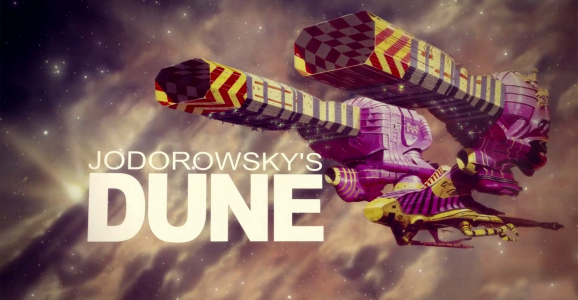Movie Review: Jodorowsky’s Dune
This article is more than 2 years old
 For every movie that makes it to screen, there are dozens that die along the way. A producer commissions a screenplay from a screenwriter, then hires a director, and then starts hiring artists and technicians to bring the movie to life…but sometimes it’s not enough. One of the most legendary unmade science fiction movies of all time was Chilean/French director Alejandro Jodorowsky’s film adaptation of Frank Herbert’s best-selling novel Dune in the 1970s, and the story of that project is the subject of an amazing new documentary.
For every movie that makes it to screen, there are dozens that die along the way. A producer commissions a screenplay from a screenwriter, then hires a director, and then starts hiring artists and technicians to bring the movie to life…but sometimes it’s not enough. One of the most legendary unmade science fiction movies of all time was Chilean/French director Alejandro Jodorowsky’s film adaptation of Frank Herbert’s best-selling novel Dune in the 1970s, and the story of that project is the subject of an amazing new documentary.
The tale of Jodorowsky’s attempts to adapt Herbert’s science fiction classic is the subject of Frank Pavich’s debut film, Jodorowsky’s Dune. The documentary examines why Jodorowsky took on Dune as his next project after the cult success of El Topo and Holy Mountain, and how he recruited many amazing talents for the project, including Alien screenwriter Dan O’Bannon, Swiss surrealist H. R. Giger, British artist Chris Foss, and French comic artist Jean “Moebius” Giraud.
What makes Jodorowsky’s version of Dune worthy of attention is that its production design and concept art pre-dated science fiction milestones such as Alien, Star Wars, and Blade Runner. Jodorowsky managed to employ a rogue’s gallery of the best of the best to help design his Dune. If Jodorowsky’s Dune had become a reality, the landscape of modern science fiction could have been very different. But there’s a reason why Alejandro Jodorowsky’s film didn’t make it to screen, which Frank Pavich’s documentary almost glosses over.
Jodorowsky put so much time and energy into the pre-production process and celebrity casting — at one time Salvador Dalí, Orson Welles, Gloria Swanson, Mick Jagger, and David Carradine were all involved in the project — that there wasn’t much money left in the film’s budget to actually make the movie. Jodorowsky had even shopped around his massive and impressive production book to major motion picture studios in the hopes of getting enough funding to continue with the project. However, the phonebook-sized screenplay and storyboards (I actually wish this massive book was for sale, but only three are in existence today) would have placed Dune’s running time at around 14 hours.
Jodorowsky’s Dune never really pinpoints why these elements never came together or offers up any speculation as to how the film could actually have been made. The documentary’s focus is on Jodorowsky’s passion for art, which is arguably more important in the long run. The director is one hell of a personality and Frank Pavich is right to let Jodorowsky shine while talking about his movies. The 85-year-old director is as bright and spry as he was in the 1970s and his passion is palpable, which leaves the viewer hungry to see his version of Dune, even if it might have been unfilmable.
The documentary never seems to dig into the differences between unbridled passion for art and the realities of the movie business. While cinephiles will love the behind-the-scenes aspects and the cinematic speculation of what could have been, Jodorowsky’s Dune doesn’t really offer much outside of those elements. The documentary borders on repetition, but Jodorowsky himself keeps the viewers attention on why his Dune is one of the most fascinating bits of science fiction film history, and a compelling “what if?” tale.
Overall, Jodorowsky’s Dune is a good inside look at the unmaking of the film adaptation and the legacy of its production. The problem with the film’s approach is that it doesn’t offer up much outside of that and leaves you craving a deeper look at the outside forces that stood in the way of Jodorowsky’s sci-fi epic. For better or worse, we have David Lynch’s Dune, and as it stands, this documentary is a perfectly enjoyable look inside Jodorowsky’s passion for art and cinema.











